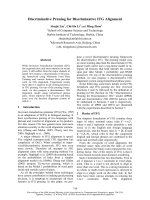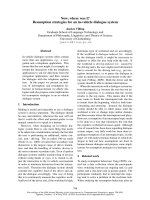Báo cáo khoa học: "Action representation for NL instructions" doc
Bạn đang xem bản rút gọn của tài liệu. Xem và tải ngay bản đầy đủ của tài liệu tại đây (189.44 KB, 2 trang )
Action representation for NL instructions
Barbara Di Eugenio*
Department of Computer and Information
Science
University of Pennsylvania
Philadelphia, PA
dieugeni~linc.cis.upenn.edu
1 Introduction
The need to represent actions arises in many differ-
ent areas of investigation, such as philosophy [5], se-
mantics [10], and planning. In the first two areas,
representations are generally developed without any
computational concerns. The third area sees action
representation mainly as functional to the more gen-
eral task of reaching a certain goal: actions have of-
ten been represented by a predicate with some argu-
ments, such as
move(John, block1, room1, room2),
augmented with a description of its effects and of
what has to be true in the world for the action to
be executable [8]. Temporal relations between ac-
tions [1], and the
generation
relation [12], [2] have
also been explored.
However, if we ever want to be able to give in-
structions in NL to active agents, such as robots and
animated figures, we should start looking at the char-
acteristics of action descriptions in NL, and devising
formalisms that should be able to represent these
characteristics, at least in principle. NL action de-
scriptions axe complex, and so are the inferences the
agent interpreting them is expected to draw.
As far as the complexity of action descriptions
goes, consider:
Ex. 1
Using a paint roller or brush, apply paste to
the wall, starting at the ceiling line and pasting down
a few feet and covering an area a few inches wider
than
the width of the fabric.
The basic description
apply paste to the wall is
augmented with the
instrument
to be used and with
direction
and
eztent
modifiers. The richness of the
possible modifications argues against representing
actions as predicates having a fixed number of ar-
guments.
Among the many complex inferences that an agent
interpreting instructions is assumed to be able to
draw, one type is of particular interest to me, namely,
the interaction between the intentional description of
an action - which I'll call the
goal
or the
why-
and
*This research was supported by DARPA grant no. N0014-
85 -K0018.
333
its executable counterpart - the
how 1. Consider:
Ex. 2
a) Place a plank between two ladders
to create a simple scaffold.
b) Place a plank between two ladders.
In both a) and b), the action to be executed
is
aplace a plank between two ladders ~.
However,
Ex. 2.b would be correctly interpreted by placing the
plank
anywhere
between the two ladders: this shows
that in a) the agent must be inferring the proper po-
sition for the plank from the expressed
why "to create
a simple scaffoldL
My concern is with representations that allow
specification of both
bow's and why's,
and with rea-
soning that allows inferences such as the above to
be made. In the rest of the paper, I will argue that
a hybrid representation formalism is best suited for
the knowledge I need to represent.
2
A hybrid action representa-
tion formalism
As I have argued elsewhere based on analysis of nat-
urally occurring data [14], [7], actions -
action types,
to be precise - must be part of the underlying ontol-
ogy of the representation formalism; partial action
descriptions must be taken as basic; not only must
the usual participants in an action such as agent or
patient be represented, but also means, manner, di-
rection, extent etc.
Given these basic assumptions, it seems that
knowledge about actions falls into the following two
categories:
1. Terminological knowledge about an action-
type: its participants and its relation to other
action-types that it either specializes or ab-
stracts - e.g.
slice
specializes
cut, loosen a screw
carefully
specializes
loosen a screw.
2. Non-terminological knowledge. First of all,
knowledge about the effects expected to occur
1V~ta.t executable
means is debatable: see for example
[12],
p. 63ff.
when an action of a given type is performed.
Because effects may occur during the perfor-
mance of an action, the basic aspectua] profile
of the action-type [11] should also be included.
Clearly, this knowledge is not terminological; in
Ex. 3 Turn the screw counterclockwise but
don't loosen it completely.
the modifier not completely does not affect
the fact that don't loosen it completely is a loos-
ening action: only its default culmination con-
dition is affected.
Also, non-terminological knowledge must in-
clude information about relations between
action-types: temporal, generation, enablement,
and testing, where by testing I refer to the rela-
tion between two actions, one of which is a test
on the outcome or execution of the other.
The generation relation was introduced by Gold-
man in [9], and then used in planning by [1], [12],
[2]: it is particularly interesting with respect to
the representation of how's and why's, because
it appears to be the relation holding between
an intentional description of an action and its
executable counterpart - see [12].
This knowledge can be seen as common.sense
planning knowledge, which includes facts such
as to loosen a screw,
you
have to turn it coun-
terelockwise, but not recipes to achieve a certain
goal [2], such as how to assemble a piece of fur-
niture.
The distinction between terminological and non-
terminological knowledge was put forward in the past
as the basis of hybrid KR system, such as those that
stemmed from the KL-ONE formalism, for example
KRYPTON [3], KL-TWO [13], and more recently
CLASSIC [4]. Such systems provide an assertional
part, or A-Box, used to assert facts or beliefs, and a
terminological part, or T-Box, that accounts for the
meaning of the complex terms used in these asser-
tions.
In the past however, it has been the case that
terms defined in the T-box have been taken to cor-
respond to noun phrases in Natural Language, while
verbs are mapped onto the predicates used in the as-
sertions stored in the A-box. What I am proposing
here is that, to represent action-types, verb phrases
too have to map to concepts in the T-Box. I am advo-
cating a 1:1 mapping between verbs and action-type
names. This is a reasonable position, given that the
entities in the underlying ontology come from NL.
The knowledge I am encoding in the T-box is at
the linguistic level: an action description is composed
of a verb, i.e. an action-type name, its arguments
and possibly, some modifiers. The A-Box contains
the non-terminological knowledge delineated above.
I have started using CLASSIC to represent actions:
it is clear that I need to tailor it to my needs, because
334
it has limited assertional capacities. I also want to
explore the feasibility of adopting techniques similar
to those used in CLASP [6] to represent what I called
common-sense planning knowledge: CLASP builds
on top of CLASSIC to represent actions, plans and
scenarios. However, in CLASP actions are still tra-
ditionally seen as STRIPS-like operators, with pre-
and post-conditions: as I hope to have shown, there
is much more to action descriptions than that.
References
[1] J. Allen. Towards a general theory of action and
time. Artificial Intelligence, 23:123-154, 1984.
[2] C. Balkanski. Modelling act-type relations in collab-
orative activity. Technical Report TR-23-90, Cen-
ter for Research in Computing Technology, Harvard
University, 1990.
[3] R. Brachman, R.Fikes, and H. Levesque. KRYP-
TON: A Functional Approach to Knowledge Repre-
sentation. Technical Report FLAIR 16, Fairchild
Laboratories for Artificial Intelligence, Palo Alto,
California, 1983.
[4] R. Bra~hman, D. McGninness, P. Patel-Schneider,
L. Alperin Resnick, and A. Borgida. Living with
CLASSIC: when and how to use a KL-ONE-IIke lan-
guage. In J. Sowa, editor, Principles of Semantic
Networks, Morgan Kaufmann Publishers, Inc., 1990.
[5] D. Davidson. Essays on Actions and Events. Oxford
University Press, 1982.
[6] P. Devanbu and D. Litman. Plan-Based Termino-
logical Reasoning. 1991. To appear in Proceedings
of KR 91, Boston.
[7] B. Di Eugenio. A language for representing action
descriptions. Preliminary Thesis Proposal, Univer-
sity of Pennsylvania, 1990. Manuscript.
[8] R. Fikes and N. Nilsson. A new approach to the
application of theorem proving to problem solving.
Artificial Intelligence, 2:189-208, 1971.
[9] A. Goldman. A Theory of Human Action. Princeton
University Press, 1970.
[10] R. Jackendoff. Semantics and Cognition. Current
Studies in Linguistics Series, The MIT Press, 1983.
[11] M. Moens and M. Steedman. Temporal Ontology
and Temporal Reference. Computational Linguis-
tics, 14(2):15-28, 1988.
[12] M. Pollack. Inferring domain plans in question-
answering. PhD thesis, University of Pennsylvania,
1986.
[13] M. VilMn. The Restricted Language Architecture
of
a Hybrid Representation System. In IJCAI-85,
1985.
[14] B. Webber and B. Di Eugenio. Free Adjuncts in
Natural Language Instructions. In Proceedings Thir-
teen& International Conference on Computational
Linguistics, COLING 90, pages 395-400, 1990.









